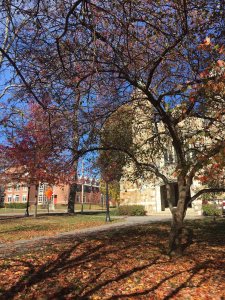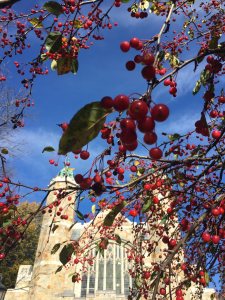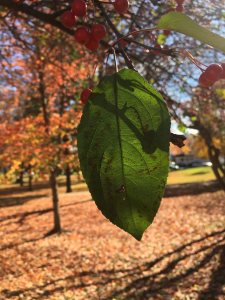Donald Wyman Crab Apple
Malus sp.| Family: Rosaceae
Submission: Nell Houde ‘18
Natural History:
 “It is remarkable how closely the history of the apple-tree is connected with that of man.” –Henry David Thoreau, 1862
“It is remarkable how closely the history of the apple-tree is connected with that of man.” –Henry David Thoreau, 1862
The Donald Wyman Crabapple (Malus sp.), one variety of the flowering crabapple, is a large tree that can reach a height of 15-20 feet at maturity. This variety was discovered as a “chance seedling” at the Arnold Arboretum around 1950, and was thus named after the Arnold Arboretum horticulturist of the time, Donald Wyman (1904-1993).
Growing best in full sunlight, the Donald Wyman Crabapple is found primarily in temperate zones in the Northern Hemisphere. The tree was brought to the United States during colonial times, and has since been naturalized across North America. Crabapple trees are grown primarily for their fruits, which are full of sugars at maturity and act as an important source of calories for wildlife and humans alike. The beauty of its springtime blossom also gives the crabapple tree ornamental value.
Crabapple trees rely upon pollinators for fertilization, as they are self-incompatible. Each new crabapple seed that is planted carries with it the genetic variation to produce many different varieties of fruits. This makes the gene pool of the crabapple large and deep, effectively randomizing the variety of fruit that is grown from a given seed. The fruits of the crabapple trees are often hosts for a variety of different fungal infections, including apple scab. The bark of the tree is often a host for fungal infections as well, including honey fungus and apple canker. Despite these infections, crabapple trees continue to thrive and act as important species for humans and other animals.
 If there is one reason people continue to propagate this tree it is because, unlike other trees, the fruit from the crabapple tree can be used for intoxication. Hard cider made from crabapples was an integral part of celebrations in Europe long before it was brought to America. Crabapples were grown in England for wassail, a spiced cider that was drunk as part of traditional celebrations of health and longevity of humans and apples. The term wassail actually comes from an old English word, “waes hael” which means, “to be healthy.”
If there is one reason people continue to propagate this tree it is because, unlike other trees, the fruit from the crabapple tree can be used for intoxication. Hard cider made from crabapples was an integral part of celebrations in Europe long before it was brought to America. Crabapples were grown in England for wassail, a spiced cider that was drunk as part of traditional celebrations of health and longevity of humans and apples. The term wassail actually comes from an old English word, “waes hael” which means, “to be healthy.”
Though people in England generally used the fruit from crabapple trees to get drunk, the crabapple tree proved to be crucial in the settlement of America. Starting as early as 1623, colonists brought seeds over from Europe to plant crabapple trees, as the crabapple is not native to North America. The orchards planted in America were used primarily for hard cider, as the fermentation of the apples sterilizes the cider through the addition of alcohol. This made the cider safer to drink than the water in early America. Everyone from small children to adults drank hard cider to keep from getting potentially fatal water-borne illnesses. Cider, and its close relative apple-jack (even stronger cider created through a process of freeze distillation) was such a staple of colonial life that people would barter and pay their bills with barrels of hard cider. Colonists soon discovered that they could prolong fertilization of hard cider to create apple cider vinegar, used to preserve vegetables via pickling. In colonial times, pickling was necessary to preserve enough food to withstand the long New England winters. Given all of the ways the crabapple can be utilized, it has unsurprisingly acted as a staple of different civilizations over the course of its long history with the human race.
“… for when man migrates, he carries with him not only his birds, quadrupeds, insects, vegetables, and his very sword, but his orchard also.” –Henry David Thoreau, 1862
Identification:
 Leaves – simple, deciduous, and alternate; elliptical-ovate, serrate; pubescent below.
Leaves – simple, deciduous, and alternate; elliptical-ovate, serrate; pubescent below.
Twigs – stout; buds usually covered with white pubescence; spur shoots.
Fruit – a pome; matures in autumn.
Flowers – white to pale pink; 5 petals; flowers in clusters; bloom in spring.
Bark – smooth when young; becomes scaly as the tree matures.
References:
Brockman, C.F. 1986. Trees of North America: A Guide to Field Identification. Revised Edition. Western Pub. Co., Inc. 280pp.
Ellis T.S. 1980. The Complete Trees of North America Field Guide and Natural History. Van Nostrand Reinhold Co., N.Y. 948 pp.
Harlow, W.M., Harrar, E.S., Hardin, J.W. and White, F.M. 1991. Textbook of Dendrology. McGraw-Hill Inc., N.Y. 501pp.
Malus ‘Donald Wyman.’ c2017. St. Louis: Missouri Botanical Gardens; [26 October 2017]. http://www.missouribotanicalgarden.org/PlantFinder/PlantFinderDetails.aspx?kempercode=d435
Petrides, G.A. 1972. A Field Guide to Trees and Shrubs. 2nd edition. Houghton Mifflin Co., Boston. 428pp.
Preston, R.J., Jr. 1989. North American Trees. 4th edition. Iowa State Univ. Press. Ames. 407pp.
Rupp, R. 8 October 2015. The Highs and Lows of Hard Apple Cider History. National Geographic. [26 October 2017]. http://theplate.nationalgeographic.com/2015/10/08/the-highs-and-lows-of-hard-apple-cider-history/
Thoreau, H.D. November 1862. Wild Apples. The Atlantic. [26 October 2017]. https://www.theatlantic.com/magazine/archive/1862/11/wild-apples/411517/
Shane, J. 2004. Dendrology Handbook, University of Vermont, Unpublished.